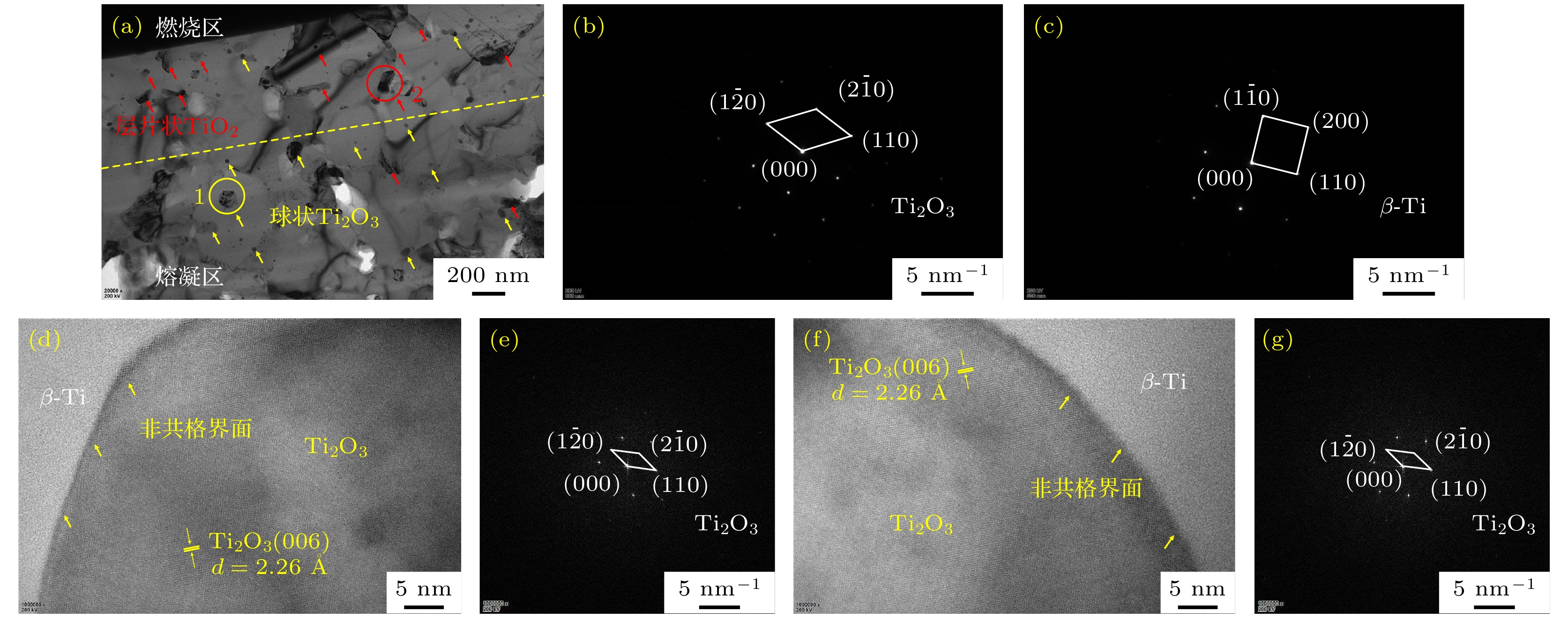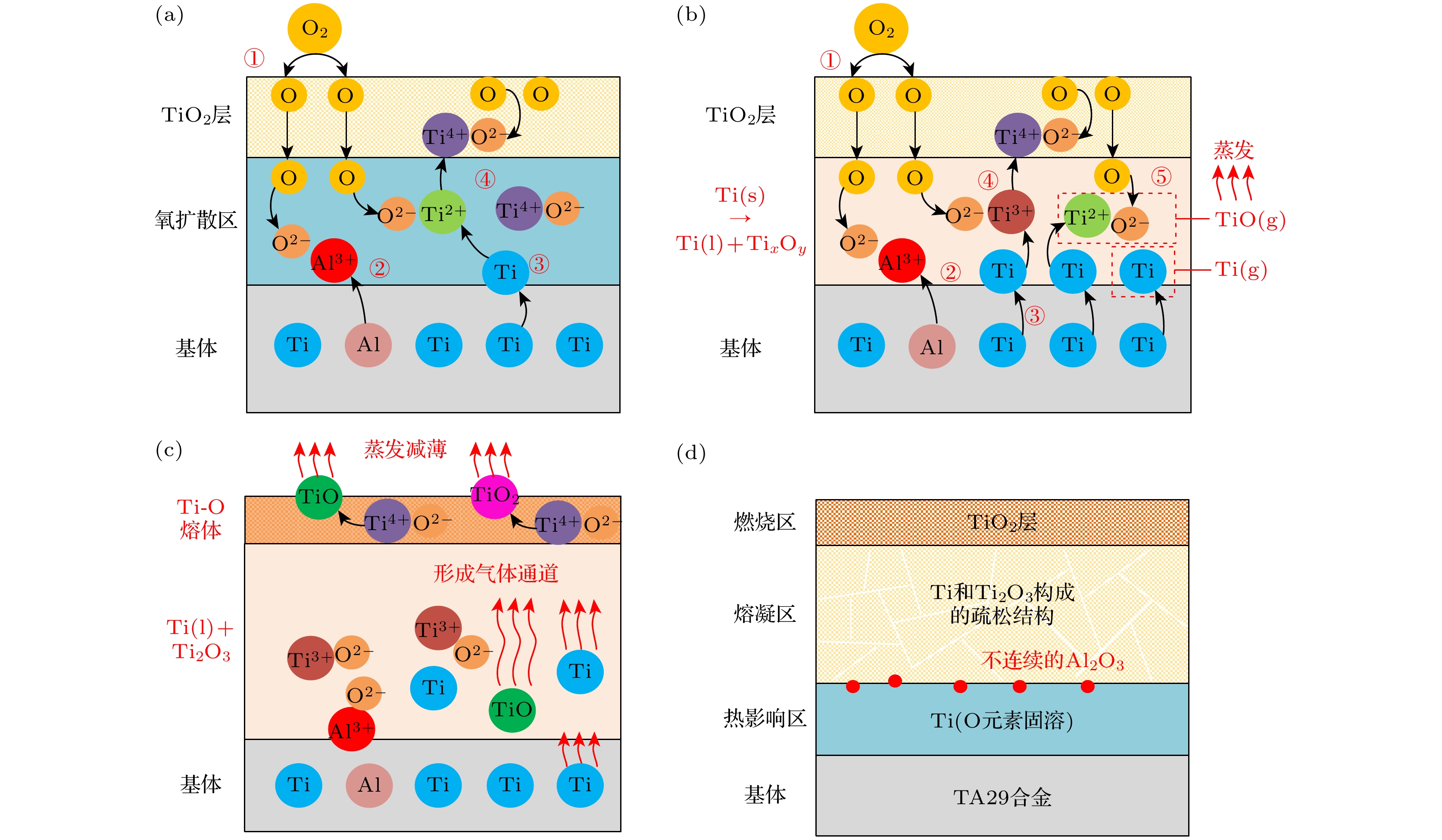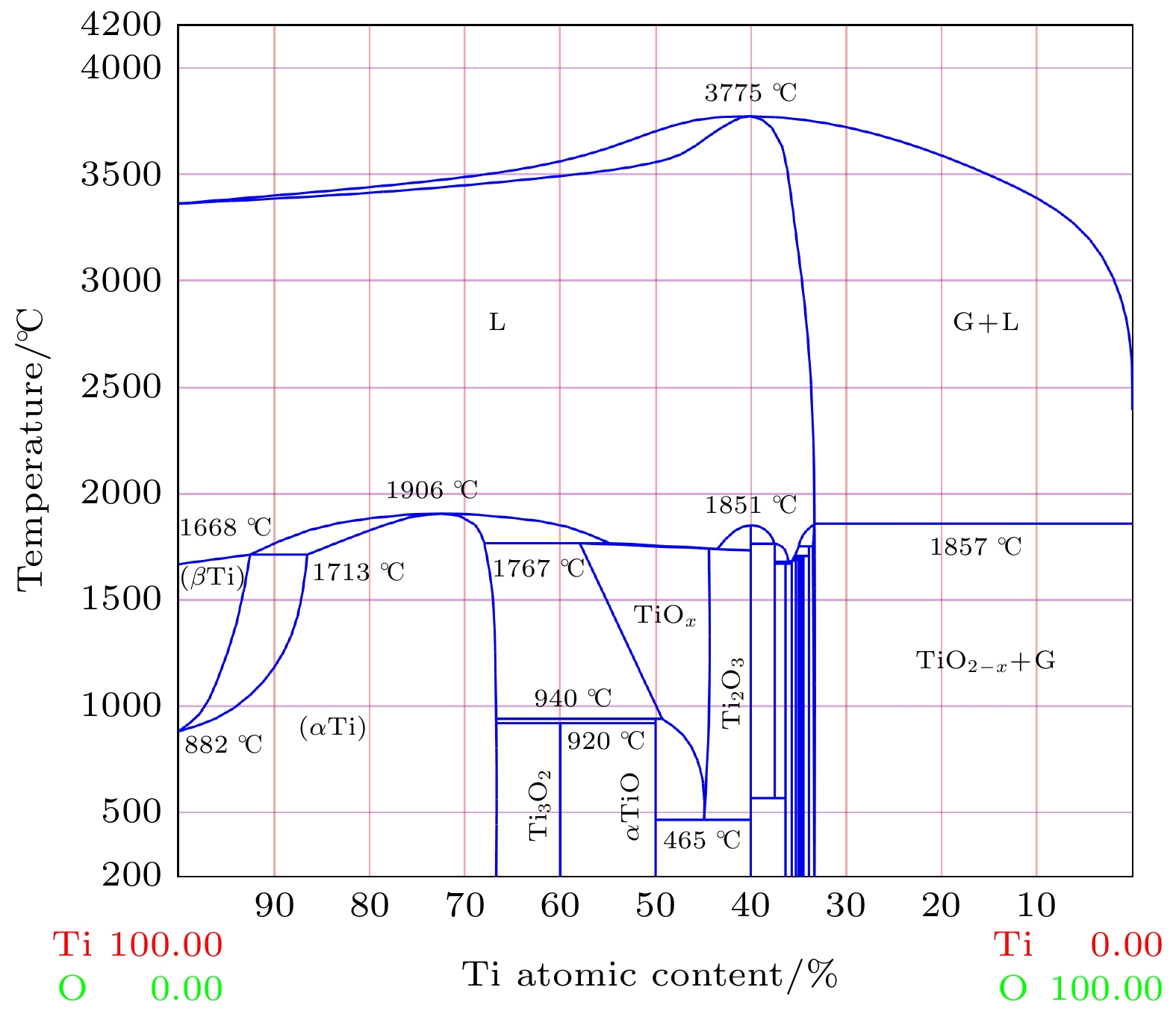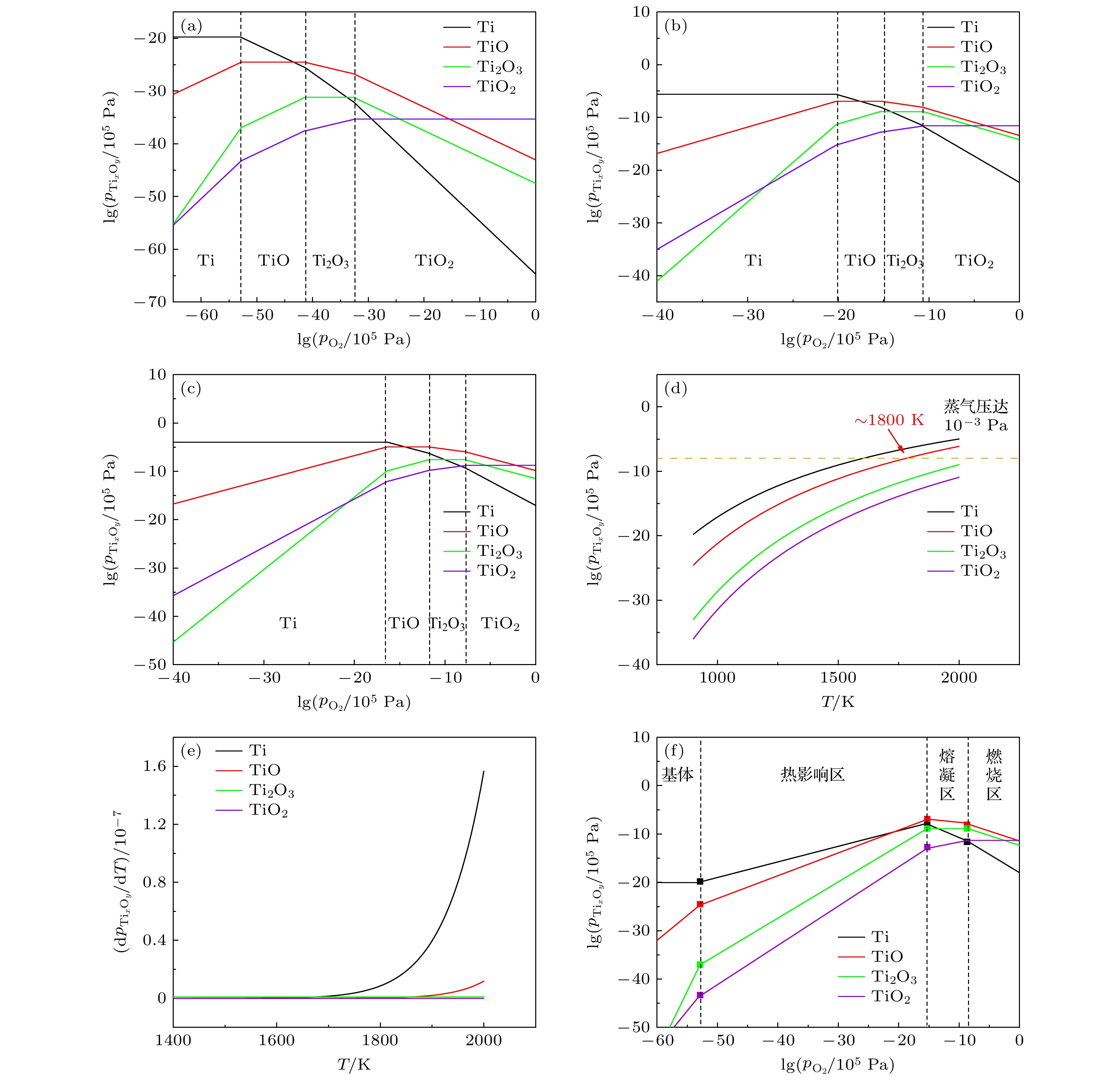-
采用摩擦氧浓度法测定600 ℃高温钛合金的阻燃性能, 通过聚焦离子束技术和高分辨电子显微镜对燃烧组织的燃烧区、熔凝区和热影响区内不同价态的氧化产物进行表征与界面结构分析, 发现燃烧产物Al2O3, Ti2O3以及TiO2具有不同于氧化过程的形成方式; 结合自由能和蒸气压计算, 揭示燃烧组织演变的机理及其对合金阻燃性能的影响. 结果表明, 合金中6%的Al元素含量导致熔凝区/热影响区界面不能形成连续性Al2O3保护层; 1800 K左右TiO蒸气压的显著增加造成熔凝区形成Ti2O3和Ti构成的疏松结构, 为氧的快速内扩散提供路径; 此外, 燃烧区中形成的TiO2熔体对基体不具有保护作用. 因此, 600 ℃高温钛合金不具备良好的阻燃性能.
-
关键词:
- 600 ℃高温钛合金 /
- 燃烧组织 /
- 燃烧机理 /
- 热力学计算
Oxides formed in the combustion process significantly affect the flame retardancy of titanium alloys, however, the evolution mechanism and formation mechanism of the combustion products of 600 ℃ high temperature titanium alloy remain uncertain. Frictional ignition method is employed in this paper to study the combustion behaviors of 600 ℃ high temperature titanium alloy, and the flame retardancy is evaluated according to the friction time, oxygen content and combustion state. In-situ observation of the burning phenomenon at the friction position and morphology after combustion is investigated, and the combustion states can be divided into oxidation stage, ignition stage and extended combustion stage. Further microstructure analysis is conducted subsequently by focus ion beam (FIB) and high resolution transmission electron microscope (HRTEM) to characterize the oxidation products with different valences in different zones of combustion microstructure. Al2O3, Ti2O3 and TiO2 are observed as the main combustion products in the heat-affected zone, melting zone and combustion zone, respectively. Notably, TiO2 is found to be formed by Ti2O3 under the combustion condition, which is different from the TiO2 transformed from the TiO mesophase under oxidation condition. This results in a lax structure composed of spherical Ti2O3 particles and porous Ti matrix in the melting zone. Thermodynamic calculations including Gibbs free energy and decomposition pressure are discussed to explain the evolution mechanisms and formation mechanisms of different oxides. It is revealed that an Al content of 6% is insufficient to form a continuous protective Al2O3 layer at the interface of the melting zone and heat affected zone. The difference in reaction path between TiO2 formed by TiO and by Ti2O3 can be ascribed to the formation of gaseous TiO phase. The sharp increase of TiO vapor pressure at about 1800 K reduces the stability of titanium oxide, thus causing the as-formed TiO to evaporate rapidly and forcing titanium to transform into TiO2 via a more stable phase, Ti2O3. The formation of the porous structure composed of Ti2O3 and Ti at the melting zone provides a path for the rapid internal diffusion of oxygen, which severely deteriorates the oxygen prevention capability of as-formed oxide layers. Besides, the TiO2 synthesized from Ti-O melt in the combustion zone can hardly protect the inner structure. Therefore, the flame retardancy of 600 ℃ high-temperature titanium alloy is far from satisfactory.-
Keywords:
- 600 ℃ high temperature titanium alloy /
- combustion microstructure /
- combustion mechanism /
- thermodynamic calculation
[1] Peters M, Kumpfert J, Ward C H, Leyens C 2003 Adv. Eng. Mater. 5 419
 Google Scholar
Google Scholar
[2] 蔡建明, 弭光宝, 高帆, 黄浩, 曹京霞, 黄旭, 曹春晓 2016 材料工程 44 1
Cai J M, Mi G B, Gao F, Huang H, Cao J X, Huang X, Cao C X 2016 J. Mater. Eng. 44 1
[3] Leyens C, Kocian K, Hausmann J, Kaysser W A 2003 Aerosp. Sci. Tech. 7 201
 Google Scholar
Google Scholar
[4] Wolf J S, Moyle D D, Pruitt A B, Bader J H 1976 J. Electrochem. Soc. 123 C251
[5] Joel S, Nathan J, Timothy G 2012 J. Astm. Int. 35 736
 Google Scholar
Google Scholar
[6] Shafirovich E, Teoh S K, Varma A 2008 Combust. Flame 152 262
 Google Scholar
Google Scholar
[7] Li X L, Hillel R, Teyssandier F, Chou S J 1992 Acta Metall. 40 3149
 Google Scholar
Google Scholar
[8] Wagner S, Arpshofen I, Seifert H J The Binary System Ti-O MSIT [2023-3-10]
[9] Leyens C, Peters M, Kaysser W A 1996 Mater. Sci. Tech. 15 1326
 Google Scholar
Google Scholar
[10] Qu S J, Tang S Q, Feng A H, Feng C, Shen J, Chen D L 2018 Acta Mater. 148 300
 Google Scholar
Google Scholar
[11] Jiang B B, Wen D H, Wang Q, Che J D, Dong C, Liao P K, Xu F, Sun L X 2019 J. Mater. Sci. Techol. 35 1008
 Google Scholar
Google Scholar
[12] Luthra K L 1991 Oxid. Met. 36 274
 Google Scholar
Google Scholar
[13] Wu H H, Trinkle D R 2011 Phys. Rev. Lett. 107 045504
 Google Scholar
Google Scholar
[14] 弭光宝, 黄旭, 曹京霞, 王宝, 曹春晓 2016 物理学报 65 056103
 Google Scholar
Google Scholar
Mi G B, Huang X, Cao J X, Wang B, Cao C X 2016 Acta Phys. Sin. 65 056103
 Google Scholar
Google Scholar
[15] Kofstad P 1967 J. L. Com. Met. 12 449
 Google Scholar
Google Scholar
[16] Shang S L, Fang H Z, Wang J 2014 Corros. Sci. 83 94
 Google Scholar
Google Scholar
[17] Muravyev N V, Monogarov K A, Zhigach A N, Leipunsky U O, Fomenkov I V, Pivkina A N 2018 Combust. Flame 191 109
 Google Scholar
Google Scholar
[18] Millogo M, Bernard S, Gillard P, Frascati F 2018 J. Loss Prev. Process Ind. 56 254
 Google Scholar
Google Scholar
[19] Derevyaga M E, Fedorin L 1976 Combust. Explo. Shock 12 493
[20] Zhao Y Q, Zhou L, Deng J 1999 Rare Metal. Mat. Eng. 28 77
[21] Rahmel A, Spencer P J 1990 Oxid. Metal 35 53
 Google Scholar
Google Scholar
[22] Zhang M, Hsieh K, Dekock J, Chang Y A 1992 Scripta Metal. Mater. 27 1361
 Google Scholar
Google Scholar
[23] Li R, Zhang P, Li X, Zhang C, Zhao J J 2013 J. Nucl. Mater. 435 71
 Google Scholar
Google Scholar
[24] Liu Z, Welsch G 1988 Metal. Trans. 19 1121
 Google Scholar
Google Scholar
[25] Scotti L, Mottura A 2016 J. Chem. Phys. 144 84701
 Google Scholar
Google Scholar
[26] Perez R A, Nakajima H, Dyment F 2003 Mater. Trans. 44 2
 Google Scholar
Google Scholar
[27] Shao L, Xie G L, Liu X H, et al. 2022 Corros. Sci. 194 109957
 Google Scholar
Google Scholar
[28] Mi G B, Huang X, Li P J, Cao J X, Huang X, Cao C X 2012 T. Nonferr. Metal. Soc. 22 2409
 Google Scholar
Google Scholar
[29] 梁贤烨, 弭光宝, 李培杰, 黄旭, 曹春晓 2020 物理学报 69 216101
 Google Scholar
Google Scholar
Liang X Y, Mi G B, Li P J, Huang X, Cao C X 2020 Acta Phys. Sin. 69 216101
 Google Scholar
Google Scholar
[30] Ouyang P X, Mi G B, Cao J X, Huang X, He L J, Li P J 2018 Mater. Today Commun. 16 364
 Google Scholar
Google Scholar
[31] Shao L, Li Z B, Yu J B, Yang G, Zhang C, Zou Y, Huang J F 2021 Corros. Sci. 192 109868
 Google Scholar
Google Scholar
[32] Shao L, Xie G L, Liu X H, Wu Y, Yu J B, Feng K, Xue W L 2021 Corros. Sci. 190 109641
 Google Scholar
Google Scholar
[33] Zhao Y Q, Zhou L, Zhu K Y, Qu H L, Wu H 2001 J. Mater. Sci. Tech. 17 677
[34] Zhao Y Q, Zhou L A, Deng J 1999 Mater. Sci. Eng. A 267 167
 Google Scholar
Google Scholar
[35] 胡庚祥, 蔡珣, 戎咏华 2010 材料科学基础 (第3版) (上海: 上海交通大学出版社) 第392—397页
Hu G X, Cai X, Rong Y H 2010 Fundamentals of Materials Science (3rd Ed.) (Shanghai: Shanghai Jiao Tong University Press) pp392–397 (in Chinese)
[36] Fischer F D, Bohm H J, Oberaigner E R, Waitz T 2006 Acta Mater. 54 151
 Google Scholar
Google Scholar
[37] Fischer F D, Svoboda J, Petryk H 2014 Acta Mater. 67 1
 Google Scholar
Google Scholar
[38] Fischer F D, Svoboda J, Antretter T, Kozeschnik E 2015 Int. J. Plast. 64 164
 Google Scholar
Google Scholar
[39] Bohm H J, Zickler G A, Fischer F D, Svoboda J 2021 Mech. Mater. 155 103781
 Google Scholar
Google Scholar
[40] Dehm G, Scheu C, Rühle M, Raj R 1998 Acta Mater. 46 759
 Google Scholar
Google Scholar
[41] Taniguchi S, Shibata T, Katoh J N 1991 Mater. Trans. 32 151
 Google Scholar
Google Scholar
[42] Wallace T A, Clark R K, Wiedemann K E, Sankaran S N 1992 Oxid. Met. 37 111
 Google Scholar
Google Scholar
[43] Shimizu T, Ikubo T, Isobe S 1992 Mater. Sci. Eng. A 153 602
 Google Scholar
Google Scholar
[44] Tang S L, Li Y F, Wang Y R, Gao Y M, Zheng Q L, Yi D W 2018 Mater. Chem. Phys. 213 538
 Google Scholar
Google Scholar
[45] 巴伦I 著 (程乃良 译) 2003 纯物质热化学数据手册 (北京: 科学出版社) 第1672—1698页
Brain I (translated by Cheng N L) 2003 Thermalchemical Data of Pure Substances (Beijing: Science Press) pp1672–1698 (in Chinese)
[46] Groves W O, Hoch M, Johnston H L 1955 J. Phys. Chem. 55 127
[47] Heideman S A, Reed T B, Gilles P W 1980 High Temp. Sci. 12 79
[48] Waldner P, Eriksson G 1999 Calphad 23 189
 Google Scholar
Google Scholar
-
图 1 TA29合金不同燃烧阶段的原位观察 (a), (b) 未燃烧TA29合金的升温(a)及冷却(b)状态; (c)—(e) 临界燃烧TA29合金的升温(c), 起燃(d)及冷却(e)阶段; (f)—(j) 充分燃烧TA29合金的升温(f), 起燃(g), 熔化(h), 燃烧(i)扩展和冷却(j)阶段
Fig. 1. In-situ observation of TA29 alloy at different ignition stages: (a), (b) Temperature rise (a) and cooling (b) stages of TA29 alloy without ignition; (c)–(e) temperature rise (c), ignition (d) and cooling (e) stages of TA29 alloy with critical ignition; (f)–(j) temperature rise (f), ignition (g), melting (h), expansion of ignition area (i) and cooling (j) stages of TA29 alloy with sufficient combustion.
图 2 不同燃烧状态TA29合金的宏观形貌 (a), (b) 未燃烧样品的摩擦表面与背侧形貌; (c), (d) 临界燃烧样品的摩擦表面与背侧形貌; (e), (f) 充分燃烧样品的摩擦表面与背侧形貌
Fig. 2. Macrostructure of TA29 alloy with different ignition states: (a), (b) Friction surface and back of samples without ignition; (c), (d) friction surface and back of samples with critical ignition; (e), (f) friction surface and back of samples with sufficient combustion.
图 5 TA29合金起燃阶段形成的冷却组织 (a) 整体形貌; (b) 基体/过渡区/热影响区放大形貌; (c) 热影响区/熔凝区/燃烧区放大形貌
Fig. 5. SEM morphology of TA29 alloy cooled at the initial ignition stage: (a) Overall morphology; (b) enlarged view of matrix/transitional zone/heat-affected zone; (c) enlarged view of heat-affected zone/fusion zone/burning zone.
图 7 TA29合金燃烧组织热影响区/熔凝区界面的TEM形貌 (a) 热影响区内Ti基体中的堆叠层错; (b) 热影响区内α-Ti的SAED图样; (c) 熔凝区内析出相的分布; (d) 图(c)中央晶粒的SAED图样; (e) Al2O3的SAED图样; (f) Al2O3/α-Ti界面的HRTEM图像
Fig. 7. TEM morphology of the combustion microstructure in the heat-affected zone/fusion zone of TA29 alloy: (a) Stacking faults in Ti matrix in heat-affected zone; (b) SAED pattern of α-Ti in heat-affected zone; (c) distribution of precipitates in fusion zone; (d) SAED pattern of the central grain in panel (c); (e) SAED pattern of Al2O3; (f) HRTEM image of Al2O3/α-Ti interface.
图 8 TA29合金燃烧组织熔凝区/燃烧区界面的TEM形貌 (a) Ti基体中大量析出相; (b)图(a)中位置1析出相电子衍射图样; (c) 图(a)中位置1周围基体的电子衍射图样; (d)图(a)中位置1处Ti2O3与基体的左侧界面HRTEM图片; (e) 图(a)中位置1处Ti2O3与基体的左侧界面FFT图像; (f) 图(a)中位置1处Ti2O3与基体的右侧界面HRTEM图片; (g) 图(a)中位置1处Ti2O3与基体的右侧界面FFT图像
Fig. 8. TEM morphology of the fusion zone/burning zone boundary of ignited TA29 alloy: (a) Precipitates in Ti matrix; (b) SAED pattern of position 1 in panel (a); (c) SAED pattern of the matrix around position 1 in panel (a); (d) HTREM image of the left interface between Ti2O3 and matrix at position 1 in panel (a); (e) FFT pattern of the left interface between Ti2O3 and matrix at position 1 in panel (a); (f) HTREM image of the right interface between Ti2O3 and matrix at position 1 in panel (a); (g) FFT pattern of the right interface between Ti2O3 and matrix at position 1 in panel (a).
图 9 金红石型TiO2/β-Ti界面处晶格畸变的HRTEM表征结果 (a) 图8(a)中位置2处TiO2析出相与β-Ti的左侧界面; (b) β-Ti的电子衍射图样; (c) TiO2的电子衍射图样; (d) 图8(a)中位置2处TiO2析出相与β-Ti的右侧界面; (e) 图(c)中位置1析出相原子排布; (f) 图(d)中位置8析出相原子排布; (g) 图(d)中位置10的β-Ti基体原子排布; (h) TiO2在
$ {\text{(1}}\overline {1} {\text{1)}} $ 晶面的原子投影; (i) TiO在$ {\text{(}}\overline {1} {\text{10)}} $ 晶面的原子投影; (j) β-Ti在$ {\text{(}}\overline {1} {\text{11)}} $ 晶面的原子投影Fig. 9. HRTEM observation of lattice distortion at the rutile TiO2/β-Ti interface: (a) Left interface of TiO2 precipitate and β-Ti at position 2 in Fig. 8(a); (b) SAED pattern of β-Ti; (c) SAED pattern of TiO2; (d) coherent interface between TiO2 and β-Ti on the right side at position 2 in Fig. 8(a); (e) atomic arrangement at position 1 in panel (c); (f) atomic arrangement at position 8 in panel (d); (g) atomic arrangement of at position 10 in panel (d); (h) projection of atoms in rutile TiO2 to
$ {\text{(1}}\overline {1} {\text{1)}} $ ; (i) projection of atoms in TiO to$ (\bar{1}10) $ ; (j) projection of atoms in β-Ti to$ (\bar{1}11) $ .图 12 TA29合金氧化及燃烧的热力学平衡关系. 不同温度下氧化组织各物质蒸气压与氧分压的关系 (a) 900 K, (b) 1900 K, (c) 2200 K. (d)最大蒸气压和(e)最大蒸气压增长速率与温度的关系; (f)燃烧组织中的蒸气压与氧分压的关系
Fig. 12. Thermodynamic balance relationship of the oxidation and burning behavior of TA29 alloy. The relationship between vapor pressure and oxygen partial pressure of substances in oxidation structure at different temperatures: (a) 900 K; (b) 1900 K; (c) 2200 K. Relationship between temperature and (d) maximum vapor pressure and (e) its growth rate; (f) relationship between vapor pressure and oxygen partial pressure in burning structure.
表 1 TA29合金摩擦实验参数与燃烧状态
Table 1. Friction experimental parameters and combustion states of TA29 alloy.
摩擦时间t = 3 s 摩擦时间t = 4 s 摩擦时间t = 5 s 氧浓度/% 燃烧状态 氧浓度/% 燃烧状态 氧浓度/% 燃烧状态 37.3 充分燃烧 36.0 充分燃烧 35.5 充分燃烧 37.0 充分燃烧 35.7 充分燃烧 35.2 充分燃烧 36.8 临界燃烧 35.4 临界燃烧 34.9 临界燃烧 36.5 未燃烧 35.1 未燃烧 34.6 未燃烧 36.2 未燃烧 34.8 未燃烧 34.3 未燃烧 表 2 TA29合金氧化阶段形成组织的元素分布
Table 2. Element distribution of TA29 alloy after oxidation stage.
元素 区域1/% 区域2/% 区域3/% 区域4/% 区域5/% Ti 81.3 83.0 74.0 80.3 65.4 Al 11.1 11.1 10.9 10.8 10.1 Zr 1.9 1.9 1.7 1.7 1.5 Sn 1.5 1.6 1.3 1.6 1.2 O 4.2 2.4 12.1 5.6 21.8 表 3 TA29合金起燃阶段冷却形成燃烧组织的元素分布
Table 3. Element distribution of TA29 alloy cooled at initial ignition stage.
元素 区域1/% 区域2/% 区域3/% 区域4/% Ti 32.7 62.7 41.2 67.2 Al 2.2 2.2 2.5 10.3 Zr 0.9 0.7 1.6 1.3 Sn 0.1 0.3 1.0 1.4 O 64.1 34.1 53.7 19.8 表 4 TA29合金扩展燃烧阶段冷却形成燃烧组织的元素分布
Table 4. Element distribution in TA29 alloy cooled at extended combustion stage.
元素 区域1/% 区域2/% 区域3/% 区域4/% 区域5/% Ti 72.1 33 32.8 40.8 59.4 Al 14.5 5.3 5.1 3.3 5.2 Zr 1.3 0.8 0.5 1.1 0.9 Sn 1.0 0.2 0.4 0.7 0.6 O 11.1 60.7 61.2 54.1 33.9 表 5 存在晶格畸变的TiO2析出相及β-Ti基体晶面间距测量值与理论值
Table 5. Measured values and theoretical values of interplane spacing in TiO2 precipitates and β-Ti matrix with lattice distortion.
间距/Å 区域 1 区域 2 区域 3 区域 4 区域 5 区域 6 区域 7 d 2.81 3.09 3.12 3.14 3.13 3.06 2.95 h 2.91 2.94 2.98 2.93 2.81 2.64 2.77 间距/Å 区域 8 区域 9 区域 10 区域 11 理想TiO 理想TiO2 理想 β-Ti d 2.62 2.59 5.41 4.80 2.41 3.57 4.68 h 2.95 2.94 2.91 2.88 2.48 2.48 2.34 表 6 TA29合金熔体的相关物性参数
Table 6. Physical parameters of TA29 alloy melt.
物理量 数值 熔体密度$ \rho $/(kg·m3) 4000 液相线温度TM/K 1873 摩尔质量M/(kg·mol) 0.04674 Ti原子半径rTi/(10–10 m) 2.00 Al原子半径rAl/(10–10 m) 1.18 表 7 不同温度下Ti-O体系单质及化合物的Gibbs自由能和平衡常数
Table 7. Gibss energy and equilibrium constant of the simple substance and compound in Ti-O system at different temperatures.
T = 900 K O2(g) Ti(s) Ti(g) TiO(s) TiO(g) Ti2O3(s) Ti2O3(g) TiO2(s) TiO2(g) 自由能G –196.7 –38.3 302.4 –592.2 –169.3 –1638.9 –1100 –1009.1 –400 自由能变化${ {\Delta } }{G^\varTheta }(T)$ 0 0 +340.7 –455.5 –32.7 –1267.3 –728.4 –774.1 –165.0 平衡常数对数lgKp — — –19.8 26.4 1.9 73.6 42.3 44.9 9.6 T = 1900 K O2(g) Ti(s) Ti(g) TiO(s) TiO(g) Ti2O3(s) Ti2O3(g) TiO2(s) TiO2(g) 自由能G –451.5 –115.7 +88.2 –695.2 –457.7 –1921.6 –1600 –1171.0 –750 自由能变化${ {\Delta } }{G^\varTheta }(T)$ 0 0 +203.9 –367.6 –116.2 –1012.8 –691.4 –603.7 –182.8 平衡常数对数lgKp — — –5.61 10.1 3.19 27.9 19.0 16.6 5.0 T = 2200 K O2(g) Ti(l) Ti(g) TiO(s) TiO(g) Ti2O3(s) Ti2O3(g) TiO2(s) TiO2(g) 自由能G –532.4 –145.2 +21.2 –756.6 –548.8 –2028.9 –1710 –1229.4 –860 自由能变化${ {\Delta } }{G^\varTheta }(T)$ 0 0 +166.3 –345.2 –137.5 –939.9 –621.0 –551.8 –182.4 平衡常数对数 lgKp — — –3.9 8.2 3.2 22.3 14.7 13.1 4.3 -
[1] Peters M, Kumpfert J, Ward C H, Leyens C 2003 Adv. Eng. Mater. 5 419
 Google Scholar
Google Scholar
[2] 蔡建明, 弭光宝, 高帆, 黄浩, 曹京霞, 黄旭, 曹春晓 2016 材料工程 44 1
Cai J M, Mi G B, Gao F, Huang H, Cao J X, Huang X, Cao C X 2016 J. Mater. Eng. 44 1
[3] Leyens C, Kocian K, Hausmann J, Kaysser W A 2003 Aerosp. Sci. Tech. 7 201
 Google Scholar
Google Scholar
[4] Wolf J S, Moyle D D, Pruitt A B, Bader J H 1976 J. Electrochem. Soc. 123 C251
[5] Joel S, Nathan J, Timothy G 2012 J. Astm. Int. 35 736
 Google Scholar
Google Scholar
[6] Shafirovich E, Teoh S K, Varma A 2008 Combust. Flame 152 262
 Google Scholar
Google Scholar
[7] Li X L, Hillel R, Teyssandier F, Chou S J 1992 Acta Metall. 40 3149
 Google Scholar
Google Scholar
[8] Wagner S, Arpshofen I, Seifert H J The Binary System Ti-O MSIT [2023-3-10]
[9] Leyens C, Peters M, Kaysser W A 1996 Mater. Sci. Tech. 15 1326
 Google Scholar
Google Scholar
[10] Qu S J, Tang S Q, Feng A H, Feng C, Shen J, Chen D L 2018 Acta Mater. 148 300
 Google Scholar
Google Scholar
[11] Jiang B B, Wen D H, Wang Q, Che J D, Dong C, Liao P K, Xu F, Sun L X 2019 J. Mater. Sci. Techol. 35 1008
 Google Scholar
Google Scholar
[12] Luthra K L 1991 Oxid. Met. 36 274
 Google Scholar
Google Scholar
[13] Wu H H, Trinkle D R 2011 Phys. Rev. Lett. 107 045504
 Google Scholar
Google Scholar
[14] 弭光宝, 黄旭, 曹京霞, 王宝, 曹春晓 2016 物理学报 65 056103
 Google Scholar
Google Scholar
Mi G B, Huang X, Cao J X, Wang B, Cao C X 2016 Acta Phys. Sin. 65 056103
 Google Scholar
Google Scholar
[15] Kofstad P 1967 J. L. Com. Met. 12 449
 Google Scholar
Google Scholar
[16] Shang S L, Fang H Z, Wang J 2014 Corros. Sci. 83 94
 Google Scholar
Google Scholar
[17] Muravyev N V, Monogarov K A, Zhigach A N, Leipunsky U O, Fomenkov I V, Pivkina A N 2018 Combust. Flame 191 109
 Google Scholar
Google Scholar
[18] Millogo M, Bernard S, Gillard P, Frascati F 2018 J. Loss Prev. Process Ind. 56 254
 Google Scholar
Google Scholar
[19] Derevyaga M E, Fedorin L 1976 Combust. Explo. Shock 12 493
[20] Zhao Y Q, Zhou L, Deng J 1999 Rare Metal. Mat. Eng. 28 77
[21] Rahmel A, Spencer P J 1990 Oxid. Metal 35 53
 Google Scholar
Google Scholar
[22] Zhang M, Hsieh K, Dekock J, Chang Y A 1992 Scripta Metal. Mater. 27 1361
 Google Scholar
Google Scholar
[23] Li R, Zhang P, Li X, Zhang C, Zhao J J 2013 J. Nucl. Mater. 435 71
 Google Scholar
Google Scholar
[24] Liu Z, Welsch G 1988 Metal. Trans. 19 1121
 Google Scholar
Google Scholar
[25] Scotti L, Mottura A 2016 J. Chem. Phys. 144 84701
 Google Scholar
Google Scholar
[26] Perez R A, Nakajima H, Dyment F 2003 Mater. Trans. 44 2
 Google Scholar
Google Scholar
[27] Shao L, Xie G L, Liu X H, et al. 2022 Corros. Sci. 194 109957
 Google Scholar
Google Scholar
[28] Mi G B, Huang X, Li P J, Cao J X, Huang X, Cao C X 2012 T. Nonferr. Metal. Soc. 22 2409
 Google Scholar
Google Scholar
[29] 梁贤烨, 弭光宝, 李培杰, 黄旭, 曹春晓 2020 物理学报 69 216101
 Google Scholar
Google Scholar
Liang X Y, Mi G B, Li P J, Huang X, Cao C X 2020 Acta Phys. Sin. 69 216101
 Google Scholar
Google Scholar
[30] Ouyang P X, Mi G B, Cao J X, Huang X, He L J, Li P J 2018 Mater. Today Commun. 16 364
 Google Scholar
Google Scholar
[31] Shao L, Li Z B, Yu J B, Yang G, Zhang C, Zou Y, Huang J F 2021 Corros. Sci. 192 109868
 Google Scholar
Google Scholar
[32] Shao L, Xie G L, Liu X H, Wu Y, Yu J B, Feng K, Xue W L 2021 Corros. Sci. 190 109641
 Google Scholar
Google Scholar
[33] Zhao Y Q, Zhou L, Zhu K Y, Qu H L, Wu H 2001 J. Mater. Sci. Tech. 17 677
[34] Zhao Y Q, Zhou L A, Deng J 1999 Mater. Sci. Eng. A 267 167
 Google Scholar
Google Scholar
[35] 胡庚祥, 蔡珣, 戎咏华 2010 材料科学基础 (第3版) (上海: 上海交通大学出版社) 第392—397页
Hu G X, Cai X, Rong Y H 2010 Fundamentals of Materials Science (3rd Ed.) (Shanghai: Shanghai Jiao Tong University Press) pp392–397 (in Chinese)
[36] Fischer F D, Bohm H J, Oberaigner E R, Waitz T 2006 Acta Mater. 54 151
 Google Scholar
Google Scholar
[37] Fischer F D, Svoboda J, Petryk H 2014 Acta Mater. 67 1
 Google Scholar
Google Scholar
[38] Fischer F D, Svoboda J, Antretter T, Kozeschnik E 2015 Int. J. Plast. 64 164
 Google Scholar
Google Scholar
[39] Bohm H J, Zickler G A, Fischer F D, Svoboda J 2021 Mech. Mater. 155 103781
 Google Scholar
Google Scholar
[40] Dehm G, Scheu C, Rühle M, Raj R 1998 Acta Mater. 46 759
 Google Scholar
Google Scholar
[41] Taniguchi S, Shibata T, Katoh J N 1991 Mater. Trans. 32 151
 Google Scholar
Google Scholar
[42] Wallace T A, Clark R K, Wiedemann K E, Sankaran S N 1992 Oxid. Met. 37 111
 Google Scholar
Google Scholar
[43] Shimizu T, Ikubo T, Isobe S 1992 Mater. Sci. Eng. A 153 602
 Google Scholar
Google Scholar
[44] Tang S L, Li Y F, Wang Y R, Gao Y M, Zheng Q L, Yi D W 2018 Mater. Chem. Phys. 213 538
 Google Scholar
Google Scholar
[45] 巴伦I 著 (程乃良 译) 2003 纯物质热化学数据手册 (北京: 科学出版社) 第1672—1698页
Brain I (translated by Cheng N L) 2003 Thermalchemical Data of Pure Substances (Beijing: Science Press) pp1672–1698 (in Chinese)
[46] Groves W O, Hoch M, Johnston H L 1955 J. Phys. Chem. 55 127
[47] Heideman S A, Reed T B, Gilles P W 1980 High Temp. Sci. 12 79
[48] Waldner P, Eriksson G 1999 Calphad 23 189
 Google Scholar
Google Scholar
计量
- 文章访问数: 9580
- PDF下载量: 124
- 被引次数: 0
















 下载:
下载:

















